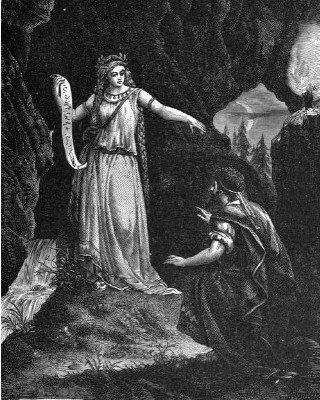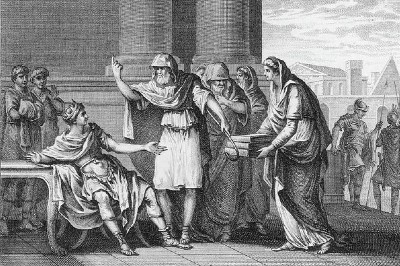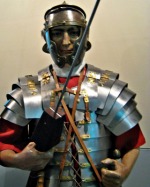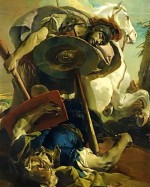The Period of Kings in Ancient Rome
Talk the Talk
Walk the Walk
 Most of what was believed about the early period of Roman history before modern archaeology comes from Titus Livius (also known as Livy), a Roman historian who lived from 59 BCE to 17 CE.
Most of what was believed about the early period of Roman history before modern archaeology comes from Titus Livius (also known as Livy), a Roman historian who lived from 59 BCE to 17 CE. Roman Kings as Listed by Titus Livius
Romulus (R. 753-715 BCE) - According to Livy, Rome was founded by the twin brothers Romulus and Remus, who soon after arriving in the area disagreed on the exact location the new settlement should be built and about the walls that would surround it. These arguments led to Romulus killing his brother and becoming the first King of Rome. Romulus then went back to his hometown to recruit new citizens for his new settlement.
Most of the people who joined him were slaves, criminals and people wishing to escape their debts; most were also male which caused a major problem. In order to secure wives for his citizens, Romulus went to a nearby settlement inhabited by the Sabine people and after getting the men drunk, kidnapped many of their women in an event that became known as the Rape of the Sabine Women. Eventually, the two settlements agreed on a truce and the Sabine king, Tatius, co-ruled with Romulus until he died, leaving the founder of Rome as sole ruler once more.
Numa Pompilius (R. 715-673 BCE) - Numa Pompilius was a Roman of Sabine descent and is credited with bringing cultural growth to the city. He is said to have brought the Vestal Virgins to Rome, founded religious collages, built the Temple of Janus and added the months of January and February to the calendar. His reign was a peaceful one which according to legend, he achieved by listening to his adviser, the nymph and prophetess Egeria (pictured above).
Tullus Hostilius (R. 673-642 BCE) - Tullus Hostilius is another king of Rome who may not have actually existed. He is said to have been a warrior king who used the Roman Army to double the population of the city by waging war on neighbouring territories; his name may even be where we get the English word hostile. He is also said to have built one of the original senate houses, the Curia Hostilia, and added Alban nobles to the Roman Senate.
Ancus Marcius (R. 642-616 BCE) - Ancus Marcius was the grandson of a previous king of Rome, Numa Pompilius. He was a warrior king who added territory after defeating the Latins in a number of battles and then moving many of their people to Rome to increase its population. He also expanded the influence of the city by building the first bridge across the River Tiber and founded the port city of Ostia.
Tarquinius Priscus (R. 616-579 BCE) - Tarquinius Priscus (also known as Tarquin the Elder) was the first Etruscan king of Rome. According to legend, when he first travelled to the city an eagle circled above his chariot before swooping down and taking the cap from his head then returned it a moment later without causing him any harm. This was an unusual way for a bird of prey to behave so his wife, Tanaquil, prophesied it meant he would one day wear the crown.
Servius Tullius (R. 578-535 BCE) - Servius Tullius, son-in-law of Tarquinius Priscus, unlike his predecessors, inherited the throne rather than being elected to it. He established the first census in Rome which was used to divide the people into tribes and classes, to determine the number of representatives each area was allowed in the Senate and how many soldiers they would need to supply during times of war. He also expanded the size of the city by erecting a huge wall encircling it that measured five miles in circumference surrounding all the seven hills of Rome and protecting them with no less than nineteen gates.
Tarquinius Superbus (R. 535-509 BCE) - Tarquinius Superbus (pictured below and also known as Tarquin the Proud) was, like his two predecessors, an Etruscan king who was the son of the former king, Tarquin the Elder and married to the daughter of Servius Tullius. He is said to have come to power by usurping the throne by having his father-in-law killed, with the help of his wife.
Influences on Early Roman Culture



Further Reading:
More Roman History
A look at the weapons, tactics and organisation of the armies of ancient Rome and how they evolved from a small civil militia in the seventh century BCE in to the most formidable fighting force in the known world by the first century BCE and eventually saw the fall of the Roman Empire by the fifth century CE.
The Roman Republic era spanned nearly five hundred years from around 509 – 31 BCE and was a time of great expansion and innovation. The foundation of Roman law was laid, infrastructure was greatly improved, the Roman army went from being a local militia to one of the most formidable professional armies the world had ever seen and the territories of ancient Rome grew exponentially.
The images on this site are believed to be in the public domain, however, if any mistakes have been made and your copyright or intellectual rights have been breeched, please contact andrew@articlesonhistory.com.




